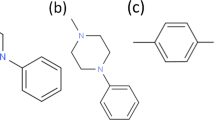Abstract
Purpose. The tight junctions in the intestinal epithelium represent highly specialized intercellular junctions. Ranitidine, an H2-antagonist, causes a tightening of the tight junctions. Hence, we have investigated the effect of ranitidine and other H2-antagonists on the function of the intestinal tight junctions.
Methods. Effect of the H2-antagonists on the tight junctions has been investigated using the transepithelial electrical resistance (TEER) and the transport of mannitol across the Caco-2 cell monolayers.
Results. Four different H2-antagonists caused an increase in the TEER across the Caco-2 cell monolayers, accompanied by a decrease in the permeability for mannitol. The effect was concentration-dependent and saturable. Ranitidine and famotidine, caused a decrease in their own transport rate across the Caco-2 cells. Ranitidine competitively inhibited the increase in TEER caused by famotidine, whereas compounds which represent molecular fragments of ranitidine had no effect. The relative potency of the four H2-antagonists in causing an increase in the TEER correlated inversely with the oral bioavailability of these compounds in humans.
Conclusions. We hypothesize that the H2-antagonists exert their effect on the tight junctions of Caco-2 cells by modulation of interactions among proteins associated with the tight junctional complex.
Similar content being viewed by others
REFERENCES
J. L. Madara. Cell. 53:497–498 (1988).
M. Cereijido, L. Gonzalez-Mariscal, R. G. Contreras, J. M. Gallardo, R. Garcia-Villegas, and J. Vldes. J. Cell Sci. Suppl. 17:127–132 (1993).
I. Hidalgo, T. Raub, and R. Borchardt. Gastroenterology. 96:736–749 (1989).
P. Artursson. J. Pharm. Sci. 79:476–482 (1990).
G. Wilson, I. Hassan, C. Dix, I. Williamson, R. Shah, M. Mackay, and P. Artursson. J. Controlled Release. 11:25–40 (1990).
A. Hilgers, R. Conradi, and P. Burton. Pharm. Res. 7:902–910 (1990).
L.-S. Gan, P.-H. Hsyu, J. F. Pritchard, and D. R. Thakker. Pharm. Res. 10:1722–1725 (1993).
J. H. Lin. Clin. Pharmacokinet. 20:218–236 (1991).
K. Tsunemasa and Y. Yutaka Morimoto. United States Patent # 4,785,122 (1988).
M. Pinto, S. Robine-Leon, M.-D. Appay, M. Kedinger, N. Triadou, E. B. Dussaulx, B. Croix, P. Simon-Assmann, K. Haffen, J. Fogh, and A. Zweibaum. Biol. Cell. 47:323–330 (1983).
K. S. Matlin, K. J. Simmons. J. Cell Biol. 99:2131–2139 (1984).
A. P. Kowalczyk, T. S. Stappenbeck, D. A. Parry, H. L. Palka, M. L. Virata, E. A. Bornslaeger, L. A. Niles, K. J. Green. Biophys. Chem. 50:97–112 (1994).
M. Takeichi. Current Opinions in Cell Biology. 7:619–627 (1995).
M. F. Williams, G. E. Dukes, W. Heizer, Y. H. Han, D. J. Hermann, T. Lampkin, and L. J. Hak. Pharm. Res. 9:1190–1194 (1992).
C. J. Young, T. K. Daneshmend, and C. J. C. Roberts. Gut. 23:819–823 (1982).
H. Echizen and T. Ishizaki. Clin. Pharmacokinet. 21:178–194 (1991).
M. P. Knadler, R. F. Bergstrom, J. T. Callaghan, B. D. Obermeyer, and A. Rubin. Clin. Pharmacol. Ther. 42:514–520 (1987).
Author information
Authors and Affiliations
Rights and permissions
About this article
Cite this article
Gan, LS.L., Yanni, S. & Thakker, D.R. Modulation of the Tight Junctions of the Caco-2 Cell Monolayers by H2-antagonists. Pharm Res 15, 53–57 (1998). https://doi.org/10.1023/A:1011944602662
Issue Date:
DOI: https://doi.org/10.1023/A:1011944602662




